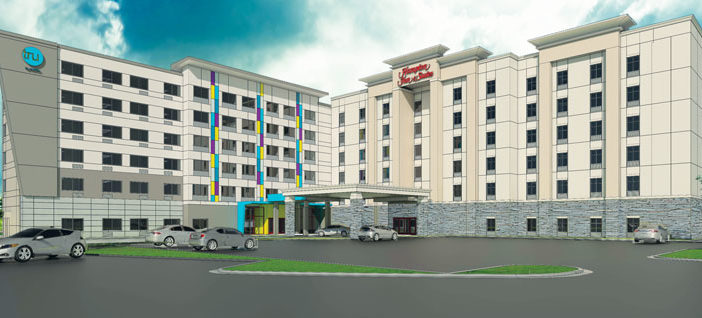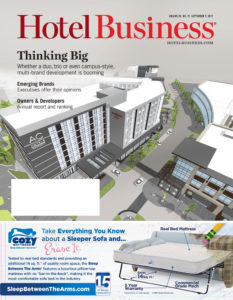While properties hosting more than one brand have been around for more than a decade, the multi-brand approach is now growing and thriving in today’s market, and maybe that’s because of the shared interest among the lodging industry’s key players—hospitality groups, asset managers, developers, owners and management companies. Each plays an essential part of the process, and the overall outlook of this trending development concept from each of its participants is—for the most part—full of optimism. This collective enthusiasm is giving legs to the multi-branded hotel movement—encouraging the industry as a whole to think bigger than ever before.
According to published data from Lodging Econometrics—a Portsmouth, NH-based global real estate intelligence company—across the United States, there are, as of the second quarter of 2017, 116 dual/multi-branded hotel projects (with a total of 15,478 rooms) under construction in the construction pipeline; 153 projects (with a total of 15,803 rooms) getting underway within the next 12 months; and 63 projects (with a total of 5,924 rooms) in the early planning stages of construction.
Hospitality groups are the ones truly driving shared site developments across market segments. These franchise companies are “trying to come up with some more unique solutions to get further brand distribution,” Bruce Ford, SVP and director of global business development at Lodging Econometrics, told Hotel Business.
“By having two or three distinct hotels under one roof, a multi-brand hotel can help a hospitality group increase its brands’ distribution and awareness in a given market—in addition to helping drive returns for the owner,” said Eric B. Jacobs, chief development officer of North America select-service and extended-stay brands at Marriott International.
For hospitality groups, the “primary advantage is the ability to address two market segments in one building,” said Bill Fortier, SVP of development in the Americas at Hilton. “There is also the benefit of having two deals versus one with the same owner or management company.” The McLean, VA-based hospitality company currently has 60 multi-branded properties globally, with roughly 120 projects in the pipeline. A dual-branded property of Hilton’s recently opened in Canada, the Homewood Suites by Hilton and Hilton Garden Inn Calgary Downtown. Hilton just broke ground on a new Tru by Hilton in Charlotte, NC, which will be a dual-brand property with Hampton by Hilton. The property will have 219 rooms, with 107 for Tru by Hilton and 112 for Hampton by Hilton. Additionally, the shared-site property will have two distinct lobbies and a dining area. Hampton Inn & Suites/Tru by Hilton Charlotte Airport Lakepointe is expected to be completed in December 2018.
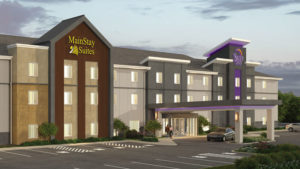
Choice Hotels International has a Sleep Inn-MainStay dual-brand concept, which attracts both short- and long-term guests.
In agreement with its competitors, Choice Hotels International has a Sleep Inn-MainStay dual-brand concept, which attracts both short- and long-term guests. “By combining these brands, not only are we meeting the different needs of travelers, but it enables developers to capitalize on transient and extended-stay markets while incorporating key features of both brands,” said Brian Quinn, VP of franchise development at the hospitality group. “In fact, ideation with our franchisees led to the development of the dual-brand concept at Choice based on what owners were hearing from guests.”
Speaking about Choice’s dual-branding strategy, Ford said: “You have one building, but rather than do maybe a traditional 100-room Sleep Inn, you’re doing 50 Sleep Inn rooms and 50 MainStay rooms, so that concept at Choice is fairly new and unique to them. It’s not how Marriott does it. It’s not really how Hilton does it.”
Fortier agreed with Quinn with regard to market segments of multi-branded properties. “For example, length of stay or quality segmentation (midscale or upscale) when you have a site big enough to accommodate both,” Fortier said. “It also makes sense when you have property management that really understands both segments and brands.” The market is what ultimately determines whether a multi-brand property will be ideal.
For Hilton, there are two general factors to examine when determining brands for multi-branded properties. “First, we’d recommend finding two segments that are not being adequately represented in the market,” the Hilton exec said. “Then find a brand that would be interested in a dual deal, and determine to what level you can share facilities. An example of an ideal combination is long stay and short stay. For urban properties, stacking abilities between the two brands may also be a consideration.”
Choice’s approach to choosing brands for properties is fairly similar to Hilton’s. “As we do with all properties, we look at the market need and performance, demand generators and our competitors, and evaluate each product to ensure we will have a successful, competitive offering that delivers on the brand promise for our Sleep Inn-MainStay dual-brand concept,” Quinn pointed out. “We have a rigorous process at Choice Hotels where we look at all aspects to meet both guest and franchisee expectations.”
In addition to the above considerations, Jacobs acknowledged the importance of brands staying authentic—despite sharing space. “The most critical factor in a dual-branded hotel project is to ensure the different brands maintain their identity—such as separate entrances and lobbies, and different design and amenities—to keep the guest experience pure, ultimately enhancing value for the owner,” he explained. The Bethesda, MD-based hospitality giant began construction on its first triple-brand property in 2016. Set to open mid-year in 2018, the 470-room hotel, which will be in Nashville, TN, will contain an AC Hotels by Marriott in one wing and a combined SpringHill Suites by Marriott and Residence Inn by Marriott in the adjoining wing.
As of August 2017, Marriott has 81 dual-branded hotels open and another 146 approved, including 62 under construction in the U.S. and Canada. These numbers reflect Marriott and Starwood, and are for select-service brand hotels in North America.
“The keys to a successful dual-brand project include finding the right location and market, identifying a complementary mix with differentiated brand experience with brands closely positioned in segmentation,” Jacobs said. “Ideally, you also are able to offer separate F&B offerings reflective of brand and market.”
While there have been some developers that are choosing to build dual-brand properties with hotels from different parent brands, there are not too many; most often, brand companies choose to stay within their own portfolio. For example, Choice only develops and operates multi-brand properties within its own portfolio. “We’ve had success with the Sleep Inn-MainStay dual-brand concept, and our plan is to continue to grow and strengthen it,” Quinn said. “Our focus is on providing the best possible products for guests and franchisees.”
Depending on brand availability, this approach can make sense for participating hospitality groups, Fortier noted. “This arrangement would have all the benefits and challenges of a standard dual-branded property, but with the added confusion for a guest trying to identify the ‘mother brand,’” he said. “From an operational perspective, you’d also be unable to share personnel, the back office and would have only one GM.”
For the world’s largest hotel company, partnering with another hospitality group on a property isn’t typically something they’d do; however, Marriott “will consider under certain circumstances,” Jacobs said, noting how such an agreement would be disadvantageous to developers partaking in this kind of deal. According to him, developers would lose operating efficiencies and shared spaces back-of-house. “When we do consider them, they are looked at as two separate hotels that happen to share the same location,” Jacobs said. “That means facades have to be different, and they can’t share things like drop-off areas and entries, meeting spaces and fitness centers.”
While hospitality group execs expect multi-branded properties will continue to grow, Choice—with 50 Sleep Inn-MainStay properties in the pipeline—expressed how the evolving guest is impacting the increased need for multi-branded properties and the way franchisees are doing business. “As guests are becoming savvier and looking for certain types of amenities, franchisees are opening dual-brand properties, so that they can offer guests variety and everything they want based on their travel needs,” Quinn explained. The hospitality group interviewed guests on preferences for both short-term and extended-stay properties before officially launching the Sleep Inn-MainStay prototype.
“I generally believe we’ll see more of these projects as land and construction costs rise and developers seek to optimize their return on investment or maximize their entitlements,” Marriott’s development exec explained. “Marriott is selective about dual-branded opportunities and limits them to where and when they make sense.”
About Marriott’s forward strategy for multi-branded properties, Jacobs said, “Marriott continues to grow its multi-brand portfolio with a view that it’s critical to ensure the different brands maintain their own identity, with separate entrances and lobbies, and different design and amenities. Keeping each brand distinct and the guest experience pure will ultimately drive increased value for the owner.”
Fortier’s optimistic about the future of multi-branded properties; he expects the pipeline to grow and thrive over the years. “Although dual-branded properties are a small part of our overall pipeline, we do believe that they will continue to grow,” he explained. “They allow owners to save on costs, maximize density and diversify their customer base.”
From an asset manager perspective, these multi-brand properties can be attractive investments if done correctly—and that’s a big “if,” pointed out Kristie Dickinson, EVP of business development and marketing at CHMWarnick, a Beverly, MA-based hotel asset management and owner advisory service company. “They can offer optimized revenue potential through product and brand diversification, appealing to a wider pool of guests and potentially groups; enhanced control over inventory/cross-selling, as well as potentially higher ancillary revenue spend with more guests on property; and on the cost side there are operating efficiencies, most notably in labor, as well as development cost efficiencies (in most cases),” she explained. Finding opportunities to enhance revenue and reduce costs through efficiencies is top of mind for asset managers; shared properties can more easily assist with these objectives.
“Within a single asset, we used to call it a ‘hotel within a hotel,’ where there was an opportunity to cater to a viable segment through product and service variations, where we would carve out a couple of floors as an ROI opportunity,” Dickinson said. “Similarly, if a single owner had more than one property in a given market, the first place we’d look to enhance value of both assets was through ‘complexing,’ capitalizing on combined purchasing power, cross-selling, joint marketing efforts and more. These two ideas—revenue diversification and cost containment—are all of the things that dual-branded properties can accomplish, plus more, when physically under one roof.”
Echoing the views of hospitality group execs on brand selection (it being a market-based decision), she also added the importance of that choice being backed by a strategy on how each brand will optimize investment objectives. “Frankly, the process is not materially different than what one would do in facilities programming or selecting any given brand,” she explained. “It simply provides one more interesting option.”
She did provide a word of caution to both owners and management companies: Avoid poor decisions resulting from ideal brands not being available. “There is no magic formula to getting these combinations right, outside of arming yourself with true industry experts who have been down this path before… Co-branding is not for amateurs,” Dickinson said.
Hank Jones, a partner at Kallenberger Jones & Co., a hotel investment consulting firm, told Hotel Business that multi-brand properties have been growing over the years because of the increasing synergies between brands. “It is clear that there has been significant growth and that this trend is gathering steam,” he said. “However, it is difficult to quantify the growth because hotels are typically not marketed as being part of a dual brand. In fact, if you were to search on the internet for a hotel that is part of a dual-brand development, you would likely find no references to its sister hotel, and the photo of the hotel you were searching would make it appear as if it were a stand-alone property.” A multi-brand property will benefit greatly if land is scarce or if the right type of land isn’t available.
“Maximize the value of the land by spreading the cost of the development (including entitlements) over more rooms,” Jones explained. “There may not be enough demand for a 300-room select-service or a 300-room extended-stay hotel, but there could be enough demand for a 150-room select-service and a 150-room extended-stay hotel.”
Other advantages of a multi-brand property include expanded market appeal, construction cost efficiencies with shared spaces, larger and more appealing public spaces, and operating cost efficiencies. “For example, payroll costs involving the GM, accounting staff, engineer, head of housekeeping and other hotel staff can be shared between the two hotels,” he said.
The process for selecting brands for multi-brand properties is oftentimes the same as choosing brands for stand-alone properties. “It starts with what does the market needs and what brands are available,” said Mark Kallenberger, partner at the Costa Mesa, CA-based hotel investment consulting firm. “From there, in a dual-branded situation, what brands are compatible. The difficulty is often trying to find two available brands—often one of the brands you want is available, but the other isn’t.”
In agreement with Jacobs, he said it’s also essential for brands at these properties to maintain a good reputation and stay authentic to market and price positioning—since there’s co-dependency between brands. “There is a risk that one of the hotels might lose its brand identity, which may harm the market image of its sister property,” he said. If the market is strong enough for one hotel, then a multi-brand property may not be needed.
“One 300-room hotel is almost always easier to construct than two 150-room hotels,” Kallenberger said. “Also, the cross-easements and other legal structures of dual-brand projects sometimes adversely affect the financing and selling prices of hotels. Brands that are too disparate in terms of the types of customers they attract are likely a bad idea. A lifestyle hotel with a raucous crowd would not mix well with a corporate staid brand. However, this is unlikely to happen since brand executives would not approve the development in the first place.”
Pairing a lesser-known brand to an established brand is also a questionable tactic, at least from an investment standpoint. “There are many new brands out there, largely untested in my opinion, and it’s easy to get caught up in taking a risk especially if key money is involved—but that could be a recipe for disaster,” Dickinson explained. “The brands being considered, and their respective room counts, still need to be financially feasible as if they were going to be built independently.” There should always be a focus on finding complementary brands, ones supporting the overall investment strategy.
“The guest experience is another aspect of dual-branding that deserves careful attention, both in physical building design, as well as in the operation,” she said. “It’s a fine line to balance the need to maintain distinct brand identities under one roof, while capitalizing the potential efficiencies. The goal of streamlining amenities is to create an enhanced experience for all guests and create a competitive advantage. But, poorly executed, this could create the opposite effect if distinct lines of division are made, prohibiting access for certain guest populations. Likewise, the experience of being connected to a brand that offers a lower level of service could negatively impact guest experience or, even worse, dilute ancillary revenue. It’s kind of like, ‘Why pay for breakfast when I can sneak over to the complimentary buffet?’”
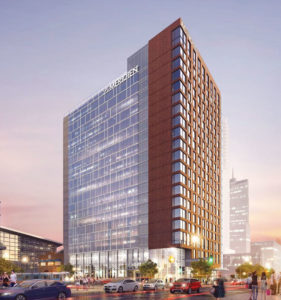
Rendering of White Lodging’s Le Méridien/AC Hotels Denver Downtown, which is expected to open this month
Deno Yiankes, president and CEO of investments and development at White Lodging in Merrillville, IN, acknowledged how diversifying market segments through multi-branded properties assists developers with mitigating risk. “[Multi-brand properties] are a way for developers to diversify their risk by serving multiple market segments via multiple reservation systems—all driving business to one location,” Yiankes said. “It’s similar to the fisherman who fishes with multiple poles versus simply one.”
White Lodging has an investment strategy with cities in mind, and multi-branded properties aid in progressing this. “With our urban-centric investment strategy, dual branding is an excellent vehicle to maximize the density of costly land, while also providing significant development and operating efficiencies,” Yiankes said. “In many cases, it allows one location to serve multiple segments without compromising the integrity of each individual brand.” White Lodging’s Le Méridien/AC Hotels Denver Downtown is expected to open this month. This project marks the first collaborative project from Marriott and former Starwood brands since the merge late last year.
“When you really think about it, multi-branding has been around since the explosion of select-service hotels in the 1980s,” Yiankes said about the emergence of multi-brand properties. “All you have to do is look at just about any suburban interstate corner—most all have multiple-branded hotels serving various market segments from one general location; they just weren’t always physically connected and had different owners.”
Mehul Patel, chairman and CEO at NewcrestImage, a Dallas-based hotel development and management company, also noted the significance of developing multi-branded properties in urban centers. “Dual-brand properties have emerged as a popular trend in recent years because they offer significantly lower costs for real estate, construction and operations—plus a wider audience for marketing initiatives,” he said “The dual-brand concept works best in larger cities or metroplex areas that must accommodate a broad range of traveler needs.”
For instance, NewcrestImage opened its first dual-brand property in 2013 near the Dallas/Fort Worth International Airport—a 181-room Courtyard by Marriott and a 120-suite TownePlace Suites by Marriott. The development and management company has two dual-brand projects in the final stage of pre-opening—one in downtown Dallas, a 128-room AC Hotel and a 121-room Residence Inn, both by Marriott; and in Oklahoma City’s historic Bricktown area, a 142-room AC Hotel and a 134-room Hyatt Place.
“Because dual-brand hotels typically bring together the benefits of select-service and extended-stay hotels in one building, we can attract guests from both of these market segments,” Patel explained. “This means we can cost-effectively market to a much broader target audience than with a single brand property. While the two hotels usually have individual entrances, they can share certain features such as a fitness center, business center, laundry, swimming pool and back-of-house space.”
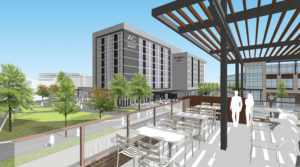
NewcrestImage has developed a “hotel campus” concept that will include four brands on the same site in Texas.
NewcrestImage has taken multi-branded properties to another level by implementing a new concept called “hotel campus,” an idea that places multiple brands immediately adjacent to each other on one site. “In North Dallas, we have broken ground on a four-brand, 600-room project that will feature an AC Hotel and a Residence Inn, both in a single building that offers 300 rooms,” he said. “There will be a Canopy by Hilton and a Hyatt Place, each in a separate building within 50 ft. of each other, and each with 150 rooms.” Keeping brands within their own hospitality group allows the hotels to take advantage of the multi-brand approach—otherwise they’d lose some of the potential benefits.
“Having one building that features two or more brands by different hotel companies is highly desirable for marketing because you can appeal to different types of travelers who participate in different rewards programs,” Patel explained. “However, this would certainly be hard to negotiate—and it wouldn’t allow an owner to share personnel among the brands, so the important dual-brand benefit of labor savings is lost.”
There are ways for management companies (at least those with the right experience) to leverage a multi-brand property as well. “Dual branding is a smart use of expensive land and a financially responsible operating model that experienced management companies can use to deliver truly superior results,” said Gerry Chase, president and COO of New Castle Hotels and Resorts, a Shelton, CT-based management company. “There are several advantages to a dual-branded property, including lower development and operating costs and better market penetration.” A dual-brand strategy may be a sensible approach when land costs are high and supply gaps are spread out across segments.
“For example, suppose the density required to make a project financially feasible is 200 rooms, but the market doesn’t need 200 of any one type,” the company’s CEO said. “By offering two different products, like a select-service and an extended-stay, you can address two different segment gaps, reach two different types of guests and achieve the necessary density to contain the development costs.”
Bob Habeeb, CEO of Rosemont, IL-based First Hospitality Group, a management and development company, pointed out the significance of multi-branded hotels in urban areas and smaller markets, something developers also appreciate. “Multi-branded hotels can be a great answer in a number of circumstances,” said Habeeb. “In urban centers, land acquisition costs can make the economics for a single hotel development difficult. In smaller markets, multi-branded hotels can allow a single site to address multiple market segments.” These developments, essentially, reduce costs through shared infrastructure costs.
Again, choosing brands for locations begins with the market. For Carrollton, TX-based Atlantic Hotels Group, studying the market first for demand is key. Then the management and development company finds brands best suitable for the market conditions. “Usually, we pick one transient and one extended-stay property to ensure we capture both types of clients,” said the company’s CEO, Perry Molubhoy.
FHG’s president and CEO agreed on pairing extended-stay properties with transient hotels. “It makes the most sense to either mix hotels by market tier or more likely by market segment,” Habeeb said. Back in January, First Hospitality Group and Hilton announced a partnership to bring the hospitality group’s first triple-brand hotel to McCormick Place in Chicago. The 466-room property will consist of the following brands: a Hilton Garden Inn, a Hampton Inn by Hilton and a Home2 Suites by Hilton.
“If the market can support additional supply, we evaluate unmet customer needs, consider brands that aren’t currently present in the market, and then ensure that the price points of the properties can support the capital investment,” New Castle’s Chase said.
One of the top markets for multi-branded properties—Nashville, TN—has 17 multi-branded projects with 1,292 rooms in the construction pipeline, as of Q2 2017. “In Nashville and the surrounding area, almost every brand is represented or under construction,” Chase added. “Brands would have to be carefully considered for additional supply.” New Castle is currently planning a dual-branded property in the surrounding area.
“In 2013, when we opened Residence Inn/Courtyard in Syracuse, there were only 26 dual-branded hotels in the entire country,” explained Chase. “By 2015, there were 79, with 54 more under construction and another 100 in development. We currently have one under construction and two more in the pipeline. I think it’s a smart play for many different situations. You’ll begin to see developers deploy this strategy with new pairings in new locations, such as resort towns. With all the consolidation, multi-branding offers some good alternative solutions to entering a market.” HB

